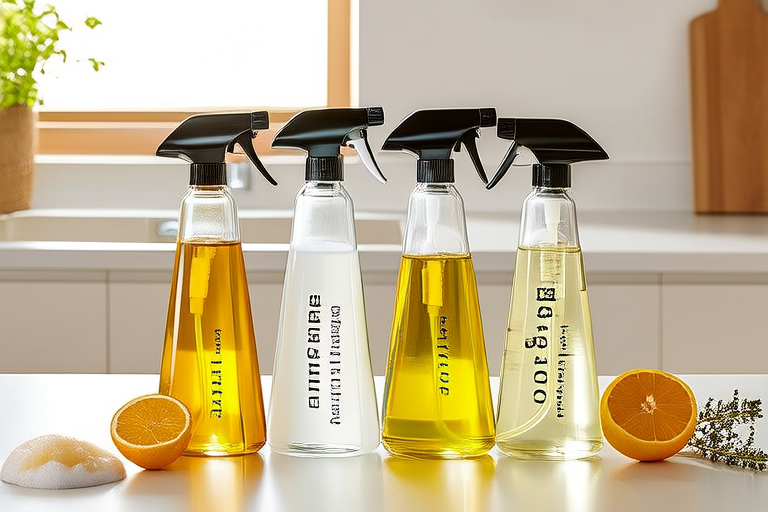5 DIY Home Surfaces Cleaning Solutions for Sparkling Results
Introduction: Why DIY Cleaning is Worth the Effort
Cleaning your home surfaces can be a daunting task, especially when you’re dealing with stubborn stains or persistent grime. Commercial cleaning products often come with harsh chemicals that can be harmful to both your health and the environment. However, by using natural ingredients found in your kitchen, you can create effective and eco-friendly cleaning solutions. Not only will these DIY methods save you money, but they’ll also help you maintain a healthier living space. In this article, we’ll explore five simple yet powerful DIY surface cleaners that will leave your home sparkling clean.
1. Vinegar and Water Solution for Glass and Mirrors
One of the most versatile DIY cleaning solutions is a mixture of white vinegar and water. This combination works wonders on glass and mirror surfaces, removing fingerprints, smudges, and dust without leaving streaks behind. Here’s how you can make it:
Ingredients:
- White vinegar: 1 cup
- Water: 1 gallon
Instructions:
- Mix the solution: Combine equal parts white vinegar and water in a spray bottle.
- Spray and wipe: Spray the solution onto the glass or mirror surface and use a lint-free cloth or newspaper to wipe it down.
- Dry: For an extra streak-free shine, follow up with a dry microfiber cloth.
Tip: Adding a few drops of essential oil like lavender or lemon can give your cleaning solution a pleasant scent while providing additional antibacterial properties.
2. Baking Soda Paste for Tough Stains
Baking soda is not just great for baking; it’s also an excellent abrasive cleaner that can tackle tough stains on various surfaces. Whether you’re dealing with burnt-on food residue on stovetops or scuff marks on floors, a simple paste made from baking soda and water can do the trick.
Ingredients:
- Baking soda: 1/2 cup
- Water: 1 tablespoon (or enough to form a paste)
Instructions:
- Make the paste: Mix baking soda with a little water until you get a thick paste.
- Apply and scrub: Apply the paste directly to the stained area and use a soft-bristled brush to scrub gently.
- Rinse and dry: Rinse thoroughly with warm water and dry the surface with a clean towel.
Tip: For particularly stubborn stains, let the paste sit for 10-15 minutes before scrubbing.
3. Lemon Juice and Salt Scrub for Stainless Steel
Stainless steel appliances and fixtures can easily become dull and discolored over time. A simple remedy is to use lemon juice and salt to restore their luster. The acid in lemon juice helps break down grease and grime, while salt acts as an abrasive to remove surface dirt.
Ingredients:
- Lemon juice: 1/2 cup
- Salt: 1/2 cup
Instructions:
- Mix the scrub: Combine lemon juice and salt to form a coarse paste.
- Apply and rub: Rub the paste onto the stainless steel surface using a circular motion.
- Wipe clean: Wipe off the excess paste with a damp cloth and dry the surface with a soft towel.
Tip: Always move in the direction of the grain when cleaning stainless steel to avoid scratches.
4. Castile Soap and Essential Oils for Multi-Surface Cleaner
Castile soap is a gentle yet effective cleaning agent that can be used on almost any surface. When combined with essential oils, it becomes a powerful all-purpose cleaner that leaves a fresh scent behind. This solution is perfect for countertops, tables, and other household surfaces.
Ingredients:
- Castile soap: 1/4 cup
- Water: 1 gallon
- Essential oils: 20 drops (optional)
Instructions:
- Mix the solution: Add castile soap to a gallon of water and stir well. If desired, add 20 drops of your favorite essential oil for fragrance.
- Spray and wipe: Use a spray bottle to apply the solution to surfaces and wipe clean with a microfiber cloth.
Tip: For best results, allow the solution to sit for a minute or two before wiping.
5. Hydrogen Peroxide and Dish Soap for Mold and Mildew
Mold and mildew can be difficult to remove, especially in areas with high humidity like bathrooms and kitchens. A solution of hydrogen peroxide and dish soap can effectively kill mold spores and eliminate mildew stains.
Ingredients:
- Hydrogen peroxide: 1 cup
- Dish soap: 1 tablespoon
Instructions:
- Mix the solution: Combine hydrogen peroxide and dish soap in a spray bottle.
- Spray and let sit: Spray the solution onto the affected areas and let it sit for at least 10 minutes.
- Scrub and rinse: Use a stiff brush to scrub away the mold and rinse with water. Dry the area thoroughly.
Tip: For persistent mold, repeat the process several times.
Practical Tips and Tricks
- Label your bottles: Clearly label each DIY cleaner so you know what it’s for and where it should be used.
- Test first: Before applying any new cleaning solution, test it on a small, inconspicuous area to ensure it doesn’t damage the surface.
- Store properly: Keep your DIY cleaners in a cool, dark place to prevent them from going bad.
Conclusion: Embrace the Power of Natural Cleaning
By incorporating these DIY cleaning solutions into your routine, you can achieve sparkling results while minimizing the use of harsh chemicals. Not only will your home look cleaner, but you’ll also contribute to a healthier environment. Start small by trying one of these recipes and gradually expand your repertoire. Remember, consistency is key in maintaining a clean and hygienic living space. Happy cleaning!
